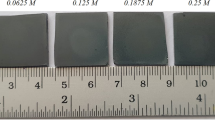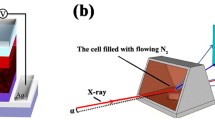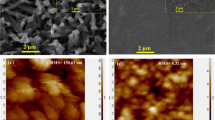Abstract
CH3NH3Pb(SCN)xI3−x films were prepared using a hot-casting method with five different Pb(SCN)2/PbI2 levels (x = 0, 0.25, 0.5, 1 and 2). Substitution of SCN− in the CH3NH3PbI3 structures induces a film color transformation from black to yellow. UV vis spectra of CH3NH3Pb(SCN)xI3−x films display an increased band gap from 1.59 eV (pure CH3NH3PbI3 film) to 2.37 eV (MAPb(SCN)2I films). Experimental XRD spectra of CH3NH3Pb(SCN)xI3−x films for increasing SCN− levels show a reduced angle of the (110) plane in the same trend as for the simulated tetragonal CH3NH3Pb(SCN)xI3−x structures. The calculated bandgap of simulated tetragonal CH3NH3Pb(SCN)xI3−x structures also increases with the SCN− concentration. Maximal efficiency, 4.56%, was gained from a carbon-based hole-transport layer (HTL)-free CH3NH3PbI3 (x = 0) perovskite solar cell. This is attributed to the low bandgap of CH3NH3PbI3 (1.59 eV). Although, the efficiency of the carbon-based HTL-free CH3NH3Pb(SCN)xI3−x solar cells decreases with increasing SCN− ratio, the excellent solar cell stability was obtained from carbon-based HTL-free CH3NH3Pb(SCN)xI3−x (x = 0.25, 0.5, 1 and 2) solar cells. This should be influenced by the presence of the hydrogen bonds between H and S and/or H and N in the CH3NH3Pb(SCN)xI3−x structures. The carbon-based HTL-free CH3NH3Pb(SCN)0.5I2.5 solar cell delivers a promising efficiency of 3.07%, and its efficiency increases by 11.40% of its initial value after 30-day storage.
Similar content being viewed by others
References
A. Kojima, K. Teshima, Y. Shirai and T. Miyasaka, J. Am. Chem. Soc. 131, 6050 (2009).
J-H. Im et al., Nanoscale 3, 4088 (2011).
NREL Efficiency Chart. https://www.nrel.gov/pv/assets/pdfs/best-research-cell-efficiencies.20191106.pdf (accessed August 8, 2019).
M. A. Green, A. Ho-Baillie and H. J. Snaith, Nat. Photonics 8, 506 (2014).
C. Wehrenfennig et al., Adv. Mater. 26, 1584 (2014).
N-G. Park, Mater. Today 18, 65 (2015).
J. Fan, B. Jia and M. Gu, Photonics Res. 2, 111 (2014).
D. Shi et al., Science 347, 519 (2015).
S. D. Stranks et al., Science 342, 341 (2013).
Z. Wang et al., J. Mater. Chem. A 7, 2773 (2019).
J. Liang et al., J. Am. Chem. Soc. 138, 15829 (2016).
L. A. Frolova et al., J. Phys. Chem. Lett. 8, 67 (2017).
X. Tan et al., Appl. Surf. Sci. 499, 143990 (2019).
J. H. Noh et al., Nano Lett. 13, 1764 (2013).
C. Liu et al., J. Am. Chem. Soc. 140, 3825 (2018).
B. Yu et al., J. Mater. Chem. A 6, 19810 (2018).
Q. Tai et al., Nat. Commun. 7, 11105 (2016).
Q. Jiang et al., Angew. Chem. Int. Ed. 54, 7617 (2015).
Y. Chen et al., Chem. Commun. 51, 11997 (2015).
Y-H. Chiang et al., ChemSusChem 9, 2620 (2016).
A. Halder et al., J. Phys. Chem. Lett. 6, 3483 (2015).
Y. Zhang et al., Metals 8, 964 (2018).
S. Maniarasu et al., Renew. Sustain. Energy Rev. 82, 845 (2018).
F. Zhang et al., ACS Appl. Mater. Interfaces 6, 16140 (2014).
H. Chen and S. Yang, Adv. Mater. 29, 1603994 (2017).
Z. Ku et al., Sci. Rep. 3, 3132 (2013).
N. Ahn et al., J. Mater. Chem. A 6, 1382 (2018).
T. Oku, Solar Cells - New Approaches and Reviews, edited by L. A. Kosyachenko (Shiga, Japan, October 22, 2015), p. 78.
T. Baikie et al., J. Mater. Chem. A 1, 5628 (2013).
G. Kresse and J. Furthmüller, Comput. Mater. Sci. 6, 15 (1996).
Q. Xi et al., Appl. Surf. Sci. 463, 1107 (2019).
Y. Iwadate, K. Kawamura, K. Igarashi and J. Mochinaga, J. Phys. Chem. 86, 5205 (1982).
J. H. Lee, J-H. Lee, E-H. Kong and H. M. Jang, Sci. Rep. 6, 21687 (2016).
W. Geng et al., J. Phys. Chem. C 118, 19565 (2014).
F. El-Mellouhi et al., ChemSusChem 9, 2648 (2016).
Acknowledgments
This work was supported by the Thailand Center of Excellence in Physics (ThEP), by the Research Network NANOTEC (RNN) program of the National Nanotechnology Center (NANOTEC) and Khon Kaen University by the National Nanotechnology Center (NANOTEC), NSTDA, Srinakharinwirot University (contract No. 676/2563), Ministry of Higher Education, Science, Research and Innovation (MHESI), Thailand, through its program of Center of Excellence Network. P. Kumlangwan would like to thank the Thailand Graduate Institute of Science and Technology (TGIST) for a NSTDA scholarship in support of her Master of Science degree under the scholar contract No. TGIST 01-57-006.
Author information
Authors and Affiliations
Corresponding authors
Supplementary Material
40042_2020_4682_MOESM1_ESM.pdf
Calculation and Fabrication of a CH3NH3Pb(SCN)xI3−x Perovskite Film as a Light Absorber in Carbon-based Hole-transport-layer-free Perovskite Solar Cells
Rights and permissions
About this article
Cite this article
Kumlangwan, P., Suksangrat, P., Towannang, M. et al. Calculation and Fabrication of a CH3NH3Pb(SCN)xI3−x Perovskite Film as a Light Absorber in Carbon-based Hole-transport-layer-free Perovskite Solar Cells. J. Korean Phys. Soc. 77, 1210–1217 (2020). https://doi.org/10.3938/jkps.77.1210
Received:
Revised:
Accepted:
Published:
Issue Date:
DOI: https://doi.org/10.3938/jkps.77.1210




